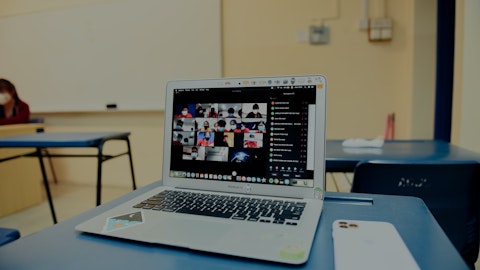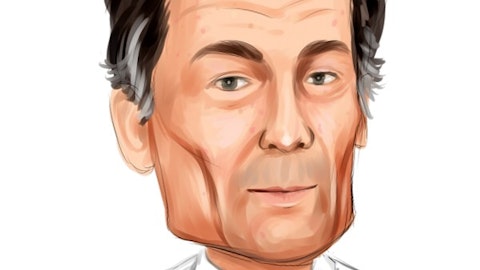Andrew Jassy: On the AWS side, my perspective, we’ll obviously all have to wait and see to some extent. But my perspective is that in 2024, you’re going to — I think a lot of the relatively low-hanging fruit on optimization has happened in 2023. It’s not to say there won’t be any more optimization. It’s just that there’s more low-hanging fruit when you have very large footprints and you’ve built a lot of applications on a platform for you to go decide to optimize if that’s what you want to go do. And so I think 2020 — we’re already seeing it now with the attenuation of optimization over the last several months. But I think you’ll continue to see the attenuation continue and we’re already seeing more and more companies that are turning their attention to newer initiatives.
And I think what you will see in ’24 and ’25 as well, I think — I don’t think it’s a 1-year deal, I think that’s going to be a several-year trajectory, is that you’re going to just see a lot of companies not just looking at the new generative AI workloads but also there was a significant number of new customer transformations where companies were going to largely move from being on-premises to being in the cloud. That got stalled in 2023 because companies were being more conservative with their spend and wary of an uncertain economy. And so I think that what you’ll see increasingly is that companies will both go back to those transformations they were planning on making and working with a lot of systems integrator partners as well as ourselves as well as start to see the production in large scale of the generative AI applications that they’re all working on and prototyping and starting to deploy into production.
I think on the ad front, well, there’s a lot I’m excited about on the ad side as well. I think that it’s interesting what’s happened in our ads business as if you look around the industry, most advertising-heavy companies have struggled growth-wise as the economy has been difficult. And while we see companies being more cautious on the ad side and the top-of-funnel products, things like display and a little bit of video, we’re still seeing a lot of strength in the lower-funnel ad products like sponsored products. And I think in these types of economies, we have fared pretty well in part because we have a number of owned and operated properties that have very large volumes that advertisers and brands want to get in front of. Even in a harder economy, there’s going to be a lot of e-commerce purchasing.
So people want to be in front of our customers in our marketplace. Or take Thursday Night Football which is we’re in our second season of Thursday Night Football and off to a great start, the ratings are 25% higher than they were a year ago through 6 weeks. But also, we’re doing much better on the advertising side than we did in our first year and that’s a property that’s really valuable. It’s the one game that week and advertisers want to be in front of customers because there’s 13 million customers a week watching. So I think part of it is because we have owned and operated properties that have a lot of volume. And then I think the other piece is that most of our resource in the advertising side is spent on machine learning expert practitioners who are owning algorithms to make sure that the sponsor results people get when they search on something are relevant.
And because of that, those ads perform better for advertisers. So when they have to think about budget decisions, they’re going to choose the ones that have large volume and perform better. I think both of those are real advantages in our advertising area right now. In terms of additional things we’re excited about. I think that we have barely scraped the surface with respect to figuring out how to intelligently integrate advertising into video, into audio and into grocery. So I think we’re early days in that. I think that we also started externalizing some of our products like sponsored products to third-party websites. And you see that with what we’ve done with Pinterest, Hearst Newspapers and BuzzFeed, so I think there’s — again, we’re still pretty early in that area but it’s growing well and we’re very focused on continuing to in a great customer experience.
Operator: And our final question comes from the line of Mark Mahaney with Evercore ISI.
Mark Mahaney: Okay. On those AWS deals Andy, that you talked about in the September quarter, was there something different about those deals, different industry, different verticals, different geographic markets? Or is it just kind of a resumption of kind of the deal flow that you’ve had in years past? So that’s the first question. And secondly, Brian, international. Is international finally at a point where it can be sustainably profitable going forwards, maybe except for the seasonally challenged March quarter? Have you wrung out enough efficiencies and gotten enough scales? And the oldest markets there are big enough and scalable enough and profitable enough that it offsets the newer countries? Have you finally reached that point?
Brian Olsavsky: First, just to give Andy a break. On international, thanks for your question. Yes, the quarter was just short of breakeven. And as you pointed out, that’s a departure from kind of prior trends. I would answer that question this way. There’s multiple things going on internationally. In our established countries, U.K., Germany, Japan, France, those countries are profitable and have been profitable. And we continue to work on price selection and convenience. And all that retail base is essentially adding sellers, adding vendors and selection, scaling advertising and improving the cost structure of our ops network. So many of the ops productivity initiatives, probably with the exception of regionalization, is more of a U.S. side right now.
But we’re working on all those productivity elements and speed concurrently globally. And you’re seeing that internationally and customers are responding. On the emerging side, over the last 6 years, we’ve launched 10 new countries. History has shown us that those all take time to grow into profitability. The U.S. took 10 years — excuse me, 9 years originally. And they’re all on their own journey there with growth and scale and profitability and selection and a number of other variables. So that’s — those are all going well as well. We continue — we’re going to continue to invest internationally in things like Prime and expanding Prime benefits and we’re going to continue to build out the fulfillment and transportation networks to better serve customers.
So I can’t say it’s permanently we’ve reached a breakeven threshold for profitability. I think the trend lines are clear, though and we’ll continue to work on accelerating that journey in all countries, especially the emerging ones.
Andrew Jassy: On the AWS deals, it’s a really broad mix of industries and geographies. So it’s not comped up in one. Some are kind of first really big deals from customers. Some of them are very large expansions of existing agreements where they’ve gone from call it, 20% of their workloads to 50% of their workloads moving to AWS in the cloud. It’s also — I’m not even really including in that number, a number of really big public sector deals that we’ve done over the last chunk of time that won’t hit for a period of time; and so all these deals don’t hit in a month. They happen over a period of time as you help those customers safely transition and migrate their workloads to AWS. But it hasn’t been any one piece. And I wish I could tell you we knew exactly why they’re starting to happen in faster numbers.





